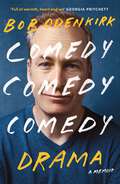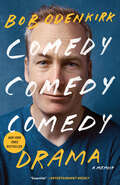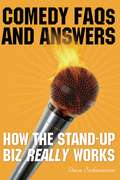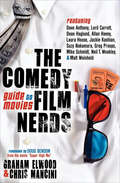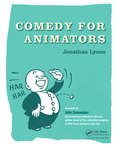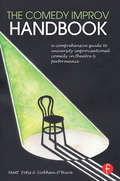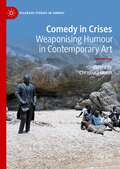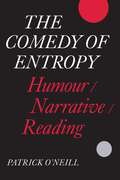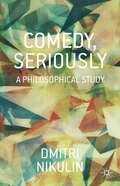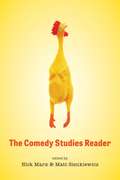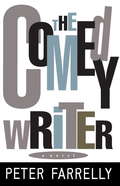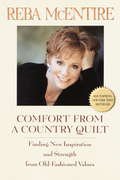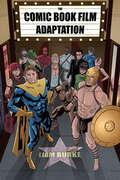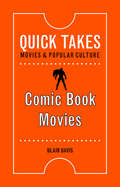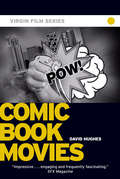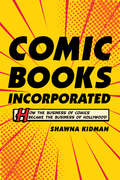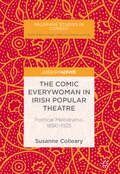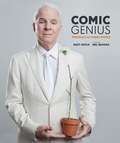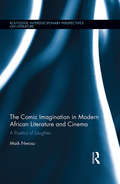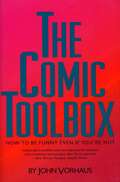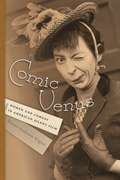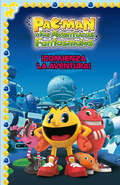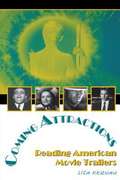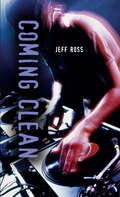- Table View
- List View
Comedy, Comedy, Comedy, Drama: A Memoir
by Bob OdenkirkIn this hilarious, heartfelt memoir, the star of Mr. Show and Breaking Bad spin off Better Call Saul opens up about the highs and lows of showbiz, his cult status as a comedy writer, and what it's like to reinvent himself at age fifty as an action-film ass-kicker.Bob Odenkirk's career is inexplicable. And yet he will try like hell to explicate it for you. Charting a "Homeric" decades-long "odyssey" from his origins in the seedy comedy clubs of Chicago to a dramatic career full of award nominations-with a side-trip into the action-man world that is baffling to all who know him-it's almost like there are many Bob Odenkirks! But there is just one, and one is plenty.Bob embraced a life in comedy after a chance meeting with Second City's legendary Del Close, then somehow made his way to a job as a writer at Saturday Night Live. While surviving that legendary gauntlet by the skin of his gnashing teeth, he stashed away the secrets of comedy writing-eventually employing them in the immortal "Motivational Speaker" sketch for Chris Farley, honing them on The Ben Stiller Show, and perfecting them on Mr. Show with Bob and David.In Hollywood, Bob demonstrated a bullheadedness that would shame Sisyphus himself, and when all hope was lost for the umpteenth time, the phone rang with an offer to appear on Breaking Bad-a show about how boring it is to be a high school chemistry teacher. His embrace of this strange new world of dramatic acting led him to working with Steven Spielberg, Alexander Payne, and Greta Gerwig, and then, in a twist that will confound you, he re-re-invented himself as a bona fide action star. Why? Read this and do your own psychoanalysis-it's fun!Featuring humorous tangents, never-before-seen photos, wild characters, and Bob's trademark unflinching drive and humour, Comedy Comedy Comedy Drama is a classic showbiz tale told by a determined idiot.
Comedy Comedy Comedy Drama: A Memoir
by Bob OdenkirkBob Odenkirk’s career is inexplicable. And yet he will try like hell to explicate it for you. Charting a “Homeric” decades-long “odyssey” from his origins in the seedy comedy clubs of Chicago to a dramatic career full of award nominations—with a side-trip into the action-man world that is baffling to all who know him—it’s almost like there are many Bob Odenkirks! But there is just one and one is plenty. <p><p> Bob embraced a life in comedy after a chance meeting with Second City’s legendary Del Close. He somehow made his way to a job as a writer at Saturday Night Live. While surviving that legendary gauntlet by the skin of his gnashing teeth, he stashed away the secrets of comedy writing—eventually employing them in the immortal “Motivational Speaker” sketch for Chris Farley, honing them on The Ben Stiller Show, and perfecting them on Mr. Show with Bob and David. <p><p> In Hollywood, Bob demonstrated a bullheadedness that would shame Sisyphus himself, and when all hope was lost for the umpteenth time, the phone rang with an offer to appear on Breaking Bad—a show about how boring it is to be a high school chemistry teacher. His embrace of this strange new world of dramatic acting led him to working with Steven Spielberg, Alexander Payne, and Greta Gerwig, and then, in a twist that will confound you, he re-re-invented himself as a bona fide action star. Why? Read this and do your own psychoanalysis—it’s fun! <p><p> Featuring humorous tangents, never-before-seen photos, wild characters, and Bob’s trademark unflinching drive, Comedy Comedy Comedy Drama is a classic showbiz tale told by a determined idiot. <p> <b>New York Times Bestseller</b>
Comedy FAQs and Answers: How the Stand-up Biz Really Works
by Dave SchwensenThis guide to the world of stand-up comedy, written in easy-to-use Q&A format, provides current and potential comedians with the no-nonsense advice they need for every stage of their careers. Schwensen's lively book features interviews with many of the top names in stand-up-Ray Romano, George Carlin, Christopher Titus, Weird Al Yankovic, Margaret Cho-all sharing lessons learned along the way. Additional interviews with club owners, talent executives, publicists, and others provide behind-the-scenes expertise.
The Comedy Film Nerds Guide to Movies: Featuring Dave Anthony, Lord Carrett, Dean Haglund, Allan Havey, Laura House, Jackie Kashian, Suzy Nakamura, Greg ... Schmidt, Neil T. Weakley, and Matt Weinhold
by Doug Benson Chris Mancini Mike Schmidt Greg Proops Dave Anthony Graham Elwood Lord Carrett Dean Haglund Allan Havey Laura House Jackie Kashian Suzy Nakamura Neil T. Weakley Matt WeinholdA movie guide for film and comedy fans, by filmmakers and comedians, for the movie lover with a good sense of humor. Tired of the usual boring, dry movie discussion? The Comedy Film Nerds Guide to Movies is something new. Is it serious movie discussion? Is it funny? Do the writers know what the hell they are talking about? Yes, yes, yes, and yes. Okay, that’s too many yes’s, but you get the point. Graham Elwood and Chris Mancini, both professional filmmakers and comedians, created comedyfilmnerds.com to mind meld the idea of real movie talk and real funny. And they called in all of their professionally funny and filmy friends to help them. Comedians and writers who have been on everything from the Tonight Show to their own comedy specials tell you what’s what about their favorite film genres. While The Comedy Film Nerds Guide to Movies is funny and informative, each genre is given a personal touch. All of the Comedy Film Nerds have a love of film and a personal connection to each genre. Read about a love of film from an insider’s perspective. The Comedy Film Nerds Guide to Movies brings what has been missing from movie discussion for too long: a healthy dose of humor.
Comedy for Animators
by Jonathan LyonsWhile comedy writers are responsible for creating clever scripts, comedic animators have a much more complicated problem to solve: What makes a physical character funny? Comedy for Animators breaks down the answer by exploring the techniques of those who have used their bodies to make others laugh. Drawing from traditions such as commedia dell'arte, pantomime, Vaudeville, the circus, and silent and modern film, animators will learn not only to create funny characters, but also how to execute gags, create a comic climate, and use environment as a character. Whether you're creating a comic villain or a bumbling sidekick, this is the one and only guide you need to get your audience laughing! Explanation of comedic archetypes and devices will both inspire and inform your creative choices Exploration of various modes of storytelling allows you to give the right context for your story and characters Tips for creating worlds, scenarios, and casts for your characters to flourish in Companion website includes example videos and further resources to expand your skillset--check it out at www.comedyforanimators.com! Jonathan Lyons delivers simple, fun, illustrated lessons that teach readers to apply the principles of history's greatest physical comedians to their animated characters. This isn't stand-up comedy--it's the falling down and jumping around sort!
The Comedy Improv Handbook: A Comprehensive Guide to University Improvisational Comedy in Theatre and Performance
by Matt Fotis Siobhan O'HaraThe Comedy Improv Handbook: A Comprehensive Guide to University Improvisational Comedy in Theatre and Performance is a one-stop resource for both improv teachers and students, covering improv history, theory, maxims, exercises, games, and structures. You will learn the necessary skills and techniques needed to become a successful improviser, developing a basic understanding of the history of improvisation and its major influences, structures, and theories. This book also addresses issues associated with being a college improviser – like auditions, rehearsals, performances, and the dynamics of improv groups.
Comedy in Crises: Weaponising Humour in Contemporary Art (Palgrave Studies in Comedy)
by Chrisoula LionisComedy in Crises provides a novel contribution to an emerging comedy studies field, offering a fresh approach and understanding toward both the motivation and reception of humour in diverse contemporary art contexts. Drawing together research by artists, theorists, curators, and historians from around the world (from Palestine, to Greece, Brazil, and Indigenous Australia), it provides new insight into how humour is weaponised in contemporary art – focusing on its role in negotiating complex cultural identities, the expectations of art markets, the impact of historical legacies, as well as its role in bolstering cultural resilience. In so doing, this book explores a vital, yet under-explored, aspect of contemporary art. Over the last decade, we have witnessed an overwhelming emphasis on experiences of precarity and emergency in contemporary art discourse, reflecting a popular view that the decade following the outbreak of the global financial crisis has been marked by an intersection of constant crises (refugee crisis, sovereign debt crisis, environmental disaster, COVID). Comedy in Crises offers innovative analysis of the relationship between this context and the growing use of humour by artists from around the world, making clear the vital role of laughter in mediating the collective trauma that takes shape today in a period of protracted crisis.
The Comedy of Entropy: Humour/Narrative/Reading (The Royal Society of Canada Special Publications)
by Patrick O'NeillEntropic comedy is the phrase coined by Patrick O'Neill in this study to identify a particular mode of twentieth-century narrative that is not generally recognized. He describes it as the narrative expression of forms of decentred humour, or what might more loosely be called 'black humour.'O'Neill begins his investigation by examining the rise of an essentially new form of humour over the last three hundred years or so in the context of a rapid decay of confidence in traditional authoritative value systems. O'Neill analyses the resulting reorganization of the spectrum of humour, and examines th implications of this for the ways in which we read texts and the world we live in.He then turns from intellectual history to narratology and considers the relationship, in theoretical terms, of homour, play, and narrative as systems of discourse and the role of the reader as a textualizing agent.Finally, he considers some dozen twentieth-century narratives in French, German, and English (with occasional reference to other literatures) in the context of those historical and theoretical concerns. Authors of the texts analysed include Céline, Camus, Satre, and Robbe-Grillet in French; Heller, Beckett, Pynchon, Nabokov, and Joyce in English; Grass, Kafka, and Handke in German. The analyses proceed along lines suggested by structuralist, semiotic, and post-structuraist narrative and literary theory. From his analyses of these works O'Neill concludes they illustrate in narrative terms a mode of modern writing definable as entropic comedy, and he develops a taxonomy of the mode.
Comedy, Seriously
by Dmitri NikulinComedy, Seriously provides a philosophical interpretation of comedy and argues that comedy displays a particular kind of rationality that reflects philosophical thinking. In particular, that comedy is defined not so much by laughter or jokes, but rather the structure of its plot, which is isomorphic with that of the philosophical argument. Comedy allows for the resolution of a conflict and the achievement of well-being and equality through action that follows the comic plot. Moreover, such action is propelled by the 'thinker on stage, ' who, as socially and politically oppressed, contributes to the liberation of all and the achievement of the good life. Comedy, therefore, establishes the universal pattern for justice and well-being and allows us to rethink the notion of subjectivity not as the modern isolated subject, but rather as integrated with others through shared action and dialogical involvement.
The Comedy Studies Reader
by Nick Marx Matt SienkiewiczFrom classical Hollywood film comedies to sitcoms, recent political satire, and the developing world of online comedy culture, comedy has been a mainstay of the American media landscape for decades. Recognizing that scholars and students need an authoritative collection of comedy studies that gathers both foundational and cutting-edge work, Nick Marx and Matt Sienkiewicz have assembled The Comedy Studies Reader. This anthology brings together classic articles, more recent works, and original essays that consider a variety of themes and approaches for studying comedic media—the carnivalesque, comedy mechanics and absurdity, psychoanalysis, irony, genre, race and ethnicity, gender and sexuality, and nation and globalization. The authors range from iconic theorists, such as Mikhail Bakhtin, Sigmund Freud, and Linda Hutcheon, to the leading senior and emerging scholars of today. As a whole, the volume traces two parallel trends in the evolution of the field—first, comedy’s development into myriad subgenres, formats, and discourses, a tendency that has led many popular commentators to characterize the present as a “comedy zeitgeist”; and second, comedy studies’ new focus on the ways in which comedy increasingly circulates in “serious” discursive realms, including politics, economics, race, gender, and cultural power.
The Comedy Writer: A Novel
by Peter FarrellyA Confederacy of Dunces meets The Player in an offbeat, sidesplittingly hilarious novel about making it against all odds in 1990s' Hollywood, by the co-writer/director of Dumb and Dumber. When Henry Halloran's girlfriend dumped him, his Boston-based life suddenly seemed pointless. He was thirty-two with a dead-end job, and nothing on the horizon. There was obviously only one place to go: Hollywood. The Comedy Writer is the story of how Henry--armed with nothing more than a few ideas, a nothing-to-lose attitude, and the desire to be a screenwriter--joins myriad hopefuls in the City of Angels and achieves an L.A. kind of fame. From the surreal squalor of his one-room pad at the Blue Terrace apartments, he encounters nympho starlets, death-obsessed Rollerbladers, philosophical midgets, scruple-free producers, and an unforgettably psychotic roommate named Colleen. Combining the mordant wit and insight of Nathanael West with the lyricism and irony of a postmodern Candide, The Comedy Writer is a bawdy romp around and through the dream factory, in which Henry learns that while talent and integrity may be relative terms, life does, after all, have meaning. Sure to appeal to anyone who has ever dreamed of Hollywood success, who has found him- or herself a full-fledged adult without a clue for the future, or who ever thought Los Angeles might represent the end of modern civilization, The Comedy Writer is an incomparable comic tour de force marked by the kind of telling detail only a true insider can provide.
Comfort from a Country Quilt
by Reba McentireThe New York Times Bestseller That Reads Like a Back-Porch Conversation with Reba!In a dazzling career, Reba McEntire has become a true country superstar--and a trailblazing businesswoman with her own multimedia entertainment corporation. Yet she is a rare celebrity who is also beloved by her millions of fans for the way she lives her life. For Reba has balanced the demands of career and family, succeeded in show business without sacrificing her values, and kept up with the times without abandoning her country roots.Here Reba writes about the roles a modern woman tries to fill, roles as many and varied as the fabric pieces of an heirloom quilt. Facing the challenges of being a wife, mother, stepmother, daughter, sister, performer, executive, community member, and Christian, Reba has found inspiration and comfort in the values of her past as an Oklahoma ranch girl. In this generous and wise book, she shows how you can keep traditional values fresh and vital in your own search for a fulfilling life.Whether you read it for instant warmth or lasting inspiration, Comfort from a Country Quilt is a book that will make your spirits soar like the sweet high notes of a Reba McEntire song.
Comic Acting and Portraiture in Late-Georgian and Regency England
by Jim DavisThe popularity of the comic performers of late-Georgian and Regency England and their frequent depiction in portraits, caricatures and prints is beyond dispute, yet until now little has been written on the subject. In this unique study Jim Davis considers the representation of English low comic actors, such as Joseph Munden, John Liston, Charles Mathews and John Emery, in the visual arts of the period, the ways in which such representations became part of the visual culture of their time, and the impact of visual representation and art theory on prose descriptions of comic actors. Davis reveals how many of the actors discussed also exhibited or collected paintings and used painterly techniques to evoke the world around them. Drawing particularly on the influence of Hogarth and Wilkie, he goes on to examine portraiture as critique and what the actors themselves represented in terms of notions of national and regional identity.
The Comic Book Film Adaptation: Exploring Modern Hollywood's Leading Genre
by Liam BurkeIn the summer of 2000 X-Men surpassed all box office expectations and ushered in an era of unprecedented production of comic book film adaptations. This trend, now in its second decade, has blossomed into Hollywood's leading genre. From superheroes to Spartan warriors, The Comic Book Film Adaptation offers the first dedicated study to examine how comic books moved from the fringes of popular culture to the center of mainstream film production.Through in-depth analysis, industry interviews, and audience research, this book charts the cause-and-effect of this influential trend. It considers the cultural traumas, business demands, and digital possibilities that Hollywood faced at the dawn of the twenty-first century. The industry managed to meet these challenges by exploiting comics and their existing audiences. However, studios were caught off-guard when these comic book fans, empowered by digital media, began to influence the success of these adaptations. Nonetheless, filmmakers soon developed strategies to take advantage of this intense fanbase, while codifying the trend into a more lucrative genre, the comic book movie, which appealed to an even wider audience. Central to this vibrant trend is a comic aesthetic in which filmmakers utilize digital filmmaking technologies to engage with the language and conventions of comics like never before.The Comic Book Film Adaptation explores this unique moment in which cinema is stimulated, challenged, and enriched by the once-dismissed medium of comics.
Comic Book Movies (Quick Takes: Movies and Popular Culture)
by Blair DavisComic Book Movies explores how this genre serves as a source for modern-day myths, sometimes even incorporating ancient mythic figures like Thor and Wonder Woman’s Amazons, while engaging with the questions that haunt a post-9/11 world: How do we define heroism and morality today? How far are we willing to go when fighting terror? How can we resist a dystopian state? Film scholar Blair Davis also considers how the genre’s visual style is equally important as its weighty themes, and he details how advances in digital effects have allowed filmmakers to incorporate elements of comic book art in innovative ways. As he reveals, comic book movies have inspired just as many innovations to Hollywood’s business model, with film franchises and transmedia storytelling helping to ensure that the genre will continue its reign over popular culture for years to come.
Comic Book Movies - Virgin Film
by David HughesThe superheroes are back! Since the 1970s, the film world has found inspiration in comic books and graphic novels. These days no summer is complete without a major blockbuster movie based on a comic: Superman, Batman, Spider-Man, X-Men, Men in Black, Daredevil, and The Hulk. Modern special effects have made large-scale superhero epics possible, but the diversity of the comics being published has made for a wide variety of subjects, as evidenced by Ghost World, From Hell, Akira and Road to Perdition. This book looks in detail at twenty key titles, covering every step of the development from comic book panel to feature film frame. Includes interviews with key creative artists about the evolution of the films from the original comics, and speculates about future films.
Comic Books Incorporated: How the Business of Comics Became the Business of Hollywood
by Shawna KidmanComic Books Incorporated tells the story of the US comic book business, reframing the history of the medium through an industrial and transmedial lens. Comic books wielded their influence from the margins and in-between spaces of the entertainment business for half a century before moving to the center of mainstream film and television production. This extraordinary history begins at the medium’s origin in the 1930s, when comics were a reviled, disorganized, and lowbrow mass medium, and surveys critical moments along the way—market crashes, corporate takeovers, upheavals in distribution, and financial transformations. Shawna Kidman concludes this revisionist history in the early 2000s, when Hollywood had fully incorporated comic book properties and strategies into its business models and transformed the medium into the heavily exploited, exceedingly corporate, and yet highly esteemed niche art form we know so well today.
The Comic Everywoman in Irish Popular Theatre: Political Melodrama, 1890-1925 (Palgrave Studies in Comedy)
by Susanne CollearyThis book is a comprehensive study of comic women in performance as Irish Political Melodrama from 1890 to 1925. It maps out the performance contexts of the period, such as Irish “poor” theatre both reflecting and complicating narratives of Irish Identity under British Rule. The study investigates the melodramatic aesthetic within these contexts and goes on to analyse a selection of the melodramas by the playwrights J.W. Whitbread and P.J. Bourke. In doing so, the analyses makes plain the comic structures and intent that work across both character and action, foregrounding comic women at the centre of the discussion. Finally, the book applies a “practice as research” dimension to the study. Working through a series of workshops, rehearsals and a final performance, Colleary investigates comic identity and female performance through a feminist revisionist lens. She ultimately argues that the formulation of the Comic Everywoman as staged “Comic” identity can connect beyond the theatre to her “Everyday” self. This book is intended for those interested in theatre histories, comic women and in popular performance.
Comic Genius
by Matt Hoyle Mel BrooksThis star-studded tribute to the kings and queens of comedy draws together such legendary names as Steve Martin, Tina Fey, Steve Carell, Eddie Murphy, Robin Williams, Ricky Gervais, and many more. Granted extraordinary access, photographer Matt Hoyle has captured his subjects in portraits that are works of art in themselves--by turns zany and deadpan, laugh-out-loud and contemplative. Accompanying them are first-person reflections from each of the comedians on life and laughter that always cut straight to the heart of comedy: it's funny because it's true. Page after sidesplitting page in Comic Genius offers prose as engaging as each portrait is memorable. Here, in one handsome package, is the gift of laughter itself. Comic Genius is proud to support Save The Children.
The Comic Imagination in Modern African Literature and Cinema: A Poetics of Laughter (Routledge Interdisciplinary Perspectives on Literature)
by Maik NwosuThis book is a seminal study that significantly expands the interdisciplinary discourse on African literature and cinema by exploring Africa’s under-visited carnivalesque poetics of laughter. Focusing on modern African literature as well as contemporary African cinema, particularly the direct-to-video Nigerian film industry known as Nollywood, the book examines the often-neglected aesthetics of the African comic imagination. In modern African literature, which sometimes creatively traces a path back to African folklore, and in Nollywood — with its aesthetic relationship to Onitsha Market Literature — the pertinent styles range from comic simplicitas to comic magnitude with the facilitation of language, characterization, and plot by a poetics of laughter or lightness as an important aspect of style. The poetics at work is substantially carnivalesque, a comic preference or tendency that is attributable, in different contexts, to a purposeful comic sensibility or an unstructured but ingrained or virtual comic mode. In the best instances of this comic vision, the characteristic laughter or lightness can facilitate a revaluation or reappreciation of the world, either because of the aesthetic structure of signification or the consequent chain of signification. This referentiality or progressive signification is an important aspect of the poetics of laughter as the African comic imagination variously reflects, across genres, both the festival character of comedy and its pedagogical value. This book marks an important contribution to African literature, postcolonial literature, world literature, comic imagination, poetics, critical theory, and African cinema.
The Comic Toolbox: How To Be Funny Even If You're Not
by John VorhausA workbook approach to comedy writing as creative problem-solving. It offers tools of the trade such as Clash of Context, Tension and Release, The Law of Comic Opposites, The Wildly Inappropriate Response, and The Myth of the Last Great Idea to writers, comics, and anyone else who wants to be funny.
Comic Venus: Women And Comedy In American Silent Film (Contemporary Approaches To Film And Media Ser.)
by Kristen Anderson WagnerFor many people the term “silent comedy” conjures up images of Charlie Chaplin’s Little Tramp, Buster Keaton’s Stoneface, or Harold Lloyd hanging precariously from the side of a skyscraper. Even people who have never seen a silent film can recognize these comedians at a glance. But what about the female comedians? Gale Henry, Louise Fazenda, Colleen Moore, Constance Talmadge—these and numerous others were wildly popular during the silent film era, appearing in countless motion pictures and earning top salaries, and yet, their names have been almost entirely forgotten. As a consequence, recovering their history is all the more compelling given that they laid the foundation for generations of funny women, from Lucille Ball to Carol Burnett to Tina Fey. These women constitute an essential and neglected sector of film history, reflecting a turning point in women’s social and political history. Their talent and brave spirit continues to be felt today, and Comic Venus: Women and Comedy in American Silent Film seeks to provide a better understanding of women’s experiences in the early twentieth century, and to better understand and appreciate the unruly and boundary-breaking women who have followed. The diversity and breadth of archival materials explored in Comic Venus illuminate the social and historical period of comediennes and silent film. In four sections, Kristen Anderson Wagner enumerates the relationship between women and comedy, beginning with the question of why historically women weren’t seen as funny or couldn’t possibly be funny in the public and male eye, a question that persists even today. Wagner delves into the idea of women’s “delicate sensibilities,” which presumably prevented them from being funny, and in chapter two traces ideas about feminine beauty and what a woman should express versus what these comedic women did express, as Wagner notes, “comediennes challenged the assumption that beauty was a fundamental component of ideal femininity.” In chapter three, Wagner discusses how comediennes such as Clara Bow, Marie Dressler, and Colleen Moore used humor to gain recognition and power through performances of sexuality and desire. Women comedians presented “sexuality as fun and playful, suggesting that personal relationships could be fluid rather than stable.” Chapter four examines silent comediennes’ relationships to the modern world and argues that these women exemplified modernity and new womanhood. The final chapter of Comic Venus brings readers to understand comediennes and their impact on silent-era cinema, as well as their lasting influence on later generations of funny women. Comic Venus is the first book to explore the overlooked contributions made by comediennes in American silent film. Those with a taste for film and representations of femininity in comedy will be fascinated by the analytical connections and thoroughly researched histories of these women and their groundbreaking movements in comedy and stage.
¡Comienza la aventura! (Pac-Man. Primeras lecturas #Volumen)
by Varios Autores¡Alucina con esta aventura de Pac-Mac! Pac es el típico adolescente del Pac mundo excepto por tres pequeños detalles: es amarillo, redondo y, para su sorpresa, es el enemigo número 1 del malvado Lord Betrayus, el líder del Mundo de las Tinieblas. Pac y su pandilla emprenden una batalla contra los fantasmas para salvar su mundo y, sobre todo, para divertirse haciéndolo.
Coming Attractions: Reading American Movie Trailers
by Lisa KernanStarting from the premise that movie trailers can be considered a film genre, this pioneering book explores the genre's conventions and offers a primer for reading the rhetoric of movie trailers. Lisa Kernan identifies three principal rhetorical strategies that structure trailers: appeals to audience interest in film genres, stories, and/or stars. She also analyzes the trailers for twenty-seven popular Hollywood films from the classical, transitional, and contemporary eras, exploring what the rhetorical appeals within these trailers reveal about Hollywood's changing conceptions of the moviegoing audience. Kernan argues that movie trailers constitute a long-standing hybrid of advertising and cinema and, as such, are precursors to today's heavily commercialized cultural forms in which art and marketing become increasingly indistinguishable.
Coming Clean (Orca Soundings)
by Ross JeffRob wants to be a DJ - more than anything. And when his older brother Adam lands him a gig at a local all-ages club filling in for DJ Sly, Rob is ecstatic. This could be his big break, and when he finds out that the girl of his dreams will be there that first night, it seems like it is all coming together. But things fall apart - Mary Jane overdoses on Ecstasy provided by Adam, and DJ Sly turns Adam in and implicates Rob. The brothers end up on the run, evading the police while trying to force DJ Sly to tell the truth about the brothers' part in the death and Sly's own role in supplying drugs at the club.
